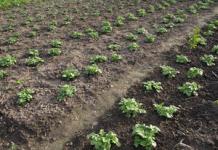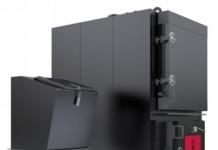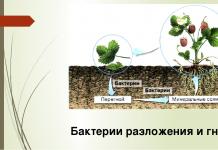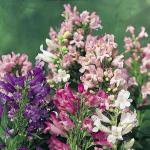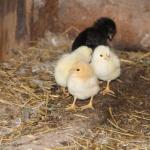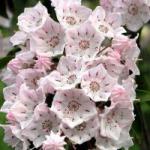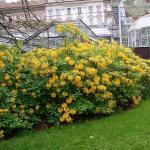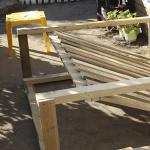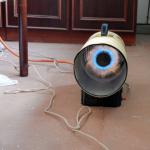Penstemon is a flower originally from North America, but recently the flower culture has become quite comfortable on the Euro-Asian continent. The plant is very decorative: a tall bush with peduncles, at the end of which are bright flowers collected in a brush. All amateur gardeners who have seen amazingly beautiful flowers would like to cultivate the plant in their garden. They are interested in the question: how to grow penstemon?
Penstemon: planting and care
The most popular is the perennial penstemon. Growing penstemon from seeds requires considerable work and patience.
In order to increase germination, it is recommended to keep the seeds in a cold place for a month before planting. Sowing seeds of penstemon is carried out in late February - early March. Plant seeds almost on the surface of the soil so that the developing plant receives more sunlight. From above, the sown material is sprinkled with sand a little, moistened and covered with cellophane to create a greenhouse. The room in which the plantings are kept should be warm (about +22 ... +25 degrees) and bright, then the first shoots hatch by the end of the second week.
With the advent of sprouts, the film can be removed and after a few days the seedlings can be transplanted into peat pots. Now the air temperature should be lower, preferably + 14 ... + 17 degrees. If these measures are followed, earlier flowering of the plant can be expected. After the appearance of two true leaves, landing dive. They are planted in open ground depending on the climatic zone: from mid-May to the end of May. At the same time, the distance between the bushes should be maintained at approximately 35 cm. Given the special sensitivity of penstemons to winds and weather changes, it is better for the plant to choose a well-lit place, protected from all sides. The soil should be neutral, rich in humus. For better growth, coarse sand or gravel can be added to the ground, since the plant does not tolerate stagnant moisture in the roots.
Care includes regular watering, weeding and protecting the plant from excessive evaporation of moisture on hot days. Approximately twice a month it is necessary to feed penstemon with complex fertilizers. To maintain a decorative appearance, dried flower stalks should be periodically removed. Often there is a phenomenon when the top of the plant dries up. To prevent the death of the bush, you should cut off the diseased part of the stem or even prune the entire plant so that healthy shoots appear. But falling flowers in rainy and windy weather is a normal phenomenon. In place of fallen ones, new flowers constantly grow.
Penstemon is also propagated by cuttings. In August, it is cut, and the rooted cuttings are stored at a temperature of + 3 ... + 7 degrees. The plant is planted in spring. Penstemon from cuttings blooms almost a month earlier than flowers grown from seeds.
Preparation of penstemons for wintering
Many types of penstemons do not tolerate temperatures below -10  degrees, so it is recommended to provide shelter for flower plantings for the winter. To do this, the ground part of the plant is cut off and a rather thick layer of spruce branches or foliage is created. If the wintering was painless for the plant, then on the rest of the bush, green foliage should remain until spring.
degrees, so it is recommended to provide shelter for flower plantings for the winter. To do this, the ground part of the plant is cut off and a rather thick layer of spruce branches or foliage is created. If the wintering was painless for the plant, then on the rest of the bush, green foliage should remain until spring.
Use of penstemons
The plant blooms from July to autumn frosts, decorating the place of growth with its long inflorescences. You can plant a penstemon in rows, planting it with low flowers (marigolds, ageratum, etc.), or in groups in a mixborder. Cut penstemons look great both in mono-bouquets and in combination with other flowers.
It is impossible to call penstemon popular, because it is not so often seen in our flower beds.
Only in recent years has this flower begun to gain some fame, and for good reason.
About what kind of rare guest this is - penstemon, how difficult it is to grow it in the open field, as well as what types of penstemon exist and will be discussed below.
Penstemon: varieties and varieties
If you look at the photo of penstemon, you can see some resemblance to a bell. In total, there are more than 250 types of penstemon. Among them you can find both erect and ground cover varieties.
Penstemon - excellent and unpretentious bell
The beginning of flowering in most varieties falls just in that intermediate period, when the early flowers begin to fade, and the later ones only form buds. This is where the penstemon blooms with magnificent fireworks.
The most common species in our gardens are:
- Penstemon alpine. Yellow-lilac flowers with a white throat are collected in umbrella inflorescences and look like a dense pillow.
- Penstemon is bearded. This species can reach a height of 90 cm. The flowers are in red and pink colors, similar to bells.
- penstemon bellflower. It grows from 60 to 90 cm. Flowers, as the name implies, are like bells, pink-lilac tones.
- foxglove penstemon. Growth and size does not differ from the bell-shaped. The flowers are most often light, white-pink tones.
Planting a plant
Penstemon loves sunlight, so try to find an area that is sufficiently lit for him, but at the same time, you should avoid areas that are too ventilated. The soil is preferably light, well-drained.
Seedlings are first grown from penstemon seeds. In February-March, seeds are sown without deepening into the ground, because they need sunlight to germinate. Some species are best sown for the winter.
Advice. For better germination of seeds, stratification can be carried out.
The soil for sowing should be sufficiently moist. After the seeds have been sown, they must be covered with a thin layer of sand, previously disinfected with boiling water. Crops should be covered with film or glass.
Light soil and wind protection is what is needed for the comfort of the plant.
Two weeks later, the first sprouts of penstemon should appear. This will happen if you stick to a temperature regime of 18-24 ° C.
It is better to dive seedlings into peat pots when two leaves appear on each plant. At the end of May, flowers can be planted in open ground.
It should be remembered: the earlier you plant young plants, the later they will bloom.
In addition to the seedling method, you can sow seeds directly into open ground. As with other perennials, this should be done in spring, when the danger of frost has passed, or in late autumn.
plant care
Caring for penstemons does not take much time. Although these plants require careful treatment, they are not at all picky. The main thing to take care of is drainage.
Do not allow water to stagnate near the roots of the plant, because this will cause much more damage to the flower than frost in winter. Watering the culture should be carried out regularly, especially in dry times. Don't let the roots dry out.
The ideal solution to moisture problems can be regular mulching around the perennial roots.
It is very important that water does not stagnate at the roots of the plant.
Do not forget to remove dried parts of the plant and loosen the soil around the bushes.
Before frosts, the ground part of the bushes is cut off and the penstemon is covered with spruce branches or leaves.
Fertilizer and top dressing of penstemon
Penstemon responds well to top dressing. Experienced gardeners recommend fertilizing three times per season.
It is best if it is organic or a full range of mineral fertilizers.
Fertilizers with a high level of phosphorus can be applied just before flowering. This will make the flowers fuller and brighter.
Top dressing for penstemon is very useful
Reproduction of penstemon
Penstemon can be propagated in four ways:
- Seeds. This method has already been described above.
- The division of the bush. To do this, the bush must be dug up, carefully shake off the roots from the ground and divided into several parts. Plant each part at a distance of at least 35 cm from each other.
- Cuttings. Cuttings must be cut from non-flowering shoots and stuck into the ground in a shady place. It is best to cover the top of the cuttings with a cut plastic bottle or glass jar. Cuttings take root very well if they have enough moisture. The culture is easily propagated by dividing the bush, cuttings, and layering.
- layering. In the spring, reject young shoots from the rest of the bush and cover the gap with earth. When the shoots take root, carefully separate them from the mother bush and transplant them to the right place.
Advice. Although penstemon is considered a perennial plant, it must be updated every 3-4 years, otherwise the shoots become thin and the flowers are not so lush.
Diseases and pests
Penstemon is resistant to disease. But sometimes the tops of some plants begin to dry.
As a result of this, the entire bush may die completely, so it is best to remove the diseased stem and prune the entire bush.
If you perform this procedure in a timely manner, new healthy shoots will soon appear.
Penstemon in landscape design
Penstemon is quite willful and may not get along with some of the other flowers in your garden, so gardeners advise planting it further away and giving it plenty of free space to develop.
Penstemon will make your garden light and bright
Different varieties of this flower are used in landscape design.
The rich tones of the alpine penstemon, which forms a flowering cover, are most often used in rock gardens as a ground cover.
In addition, it will look good in curb plantings.
This bearded penstemon in landscape design is used for planting in flower beds and discounts. He looks no worse in solo plantings.
The light pink flowers of the tall foxglove penstemon are in demand in combination with flowers such as chamomile, coreopsis, as well as decorative sedge and astilba.
Penstemon with other plants
You can also arrange a bed of penstemons alone, choosing varieties in such a way that multi-colored fireworks last all summer until autumn.
Penstemon, planting and caring for which is easier than it might seem at first glance, looks great in bouquets, although it does not last long.
This rare guest in the gardens is worthy of attention. It is moderately capricious, breeds easily, feels good in temperate climates.
Any variety of penstemon will find a worthy place in your garden. Do not be afraid to fantasize and your garden will acquire new colors, and penstemon will help you with this.
Penstemon in the garden: video
Types of penstemon: photo
Source: https://dachadizain.ru/cvety/mnogoletnie/penstemon-posadka-i-uxod.html
Penstemon - landing and care
Penstemon is a perennial rhizomatous plant that occurs in a bushy and creeping form. The genus includes more than 250 species that can decorate the garden with their unusually beautiful flowers of various colors, collected in chic paniculate inflorescences.
Vibrant rich green foliage is a great contrast to the white, pink, red, purple and purple bell-shaped flowers.
Landing
Penstemon is quite unpretentious, but to achieve the most decorative look, it is best to plant it in areas with bright sunlight.
In partial shade and shade, the flower is able to develop, but due to lack of light, the color of the inflorescences may be several tones paler than that of the same variety grown in the sun.
The main condition for successful maintenance in the garden is the right choice of soil for planting, which should be light and nutritious. It is necessary to ensure good drainage, exclude stagnant water in the soil and protect the plant from drafts.
Organic fertilizers, such as humus or compost, are optimal for use as top dressing. It is better to make them in the spring before the plant blooms.
Care
Despite the undemanding to planting and care, penstemon still needs attention. To prevent the soil from drying out, the surface around the plant must be mulched.
Prolonged drought can kill the plant.
To ensure oxygen access to the rhizome, it is necessary to loosen the ground, and to preserve the decorative effect and to achieve the longest flowering, it is recommended to remove faded inflorescences and dry stems.
To form neat bushes, the perennial is shortened. Do not neglect this procedure - a beautiful perennial, under favorable conditions, grows quite quickly, and the removal of excess shoots contributes to abundant flowering.
In autumn, before the onset of frost, the bushes are completely cut off and covered with spruce branches. This will help protect the flower from adverse conditions and preserve the rhizome as much as possible, which may suffer when the soil freezes.
Subject to the simplest rules of planting and care, penstemon can grow in one place for up to 4 years without losing its external characteristics.
Despite the fact that this plant is a perennial, over time, the bushes grow old and become unsightly.
In this case, it is worth thinking about updating by annually sowing seedlings or cutting adult bushes.
Reproduction of penstemon
Large bushes can be divided in early spring before the active growth stage. This is the fastest and easiest way to increase the number of plantings on the site.
Cuttings are made in the middle of summer, when fairly strong shoots have already formed on the bush.
For successful cultivation of cuttings, the top of the head is cut off from the stem 20-25 cm long and placed in water with a root formation stimulator.
After the roots appear, the stalk can be planted in open ground or placed in a pot.
Creeping varieties can be propagated by branches, sprinkling part of the stem with soil. After some time, the branch can be separated and transplanted separately from the mother plant.
If the penstemon is propagated by seeds, then they need to be sown for seedlings in early March. In this case, young plants will be able to bloom by summer. The seeds of the plant are placed in moist soil, without sprinkling on top.
It is necessary to ensure constant humidity and temperature not lower than 25 ° C. The box with crops must be covered with glass or planted in a greenhouse container. The first shoots appear in about 10-14 days.
After the appearance of 2-3 full leaves on young seedlings, they need to be planted. Peat pots are ideal for temporary placement before planting in open ground. The perennial is not too fond of frequent transplants, which can adversely affect the future life of the plant.
The grown seedlings can be transferred to open ground in early June. Planting too early will slow growth and delay flowering. In addition, spring frosts can damage young seedlings. Timely planting in a permanent place is the key to the successful development of the plant.
Species and varieties
Penstemon whitish In its natural habitat it prefers rocky soil. In height reaches no more than 30 cm.
White tubular flowers with occasional purple blotches or stripes are complemented by greyish-green foliage. Flowering occurs in early June and lasts about 2 months.
Due to the characteristics of the natural habitat, this species is perfect for planting on an alpine hill, rockeries or other compositions using crushed stone or limestone.
penstemon brilliant the most frost-resistant and unpretentious species. Characterized by early, long flowering.
Low stems form a rosette, and bright blue inflorescences look great against the backdrop of the rich foliage of the plant.
This species is used for rock gardens and in group plantings with early flowering garden plants, such as large-leaved brunner, muscari, corydalis, daffodils.
Pine-haired penstemon reaches a height of no more than 30 cm. Its bright yellow flowers densely cover weakly branched stems.
An evergreen plant in favorable conditions is able to bloom so profusely that, due to the huge number of flowers, the foliage will not be visible at all.
In the garden it is used in single and group plantings. Will grow in a container or pot. For this species, it is better to choose a slightly acidic soil with a high peat content.
For the winter, it is necessary to cover well or bring it to a cool room, since this species is not able to endure too low temperatures.
As a perennial (you can read the encyclopedia of perennials here) a ground cover plant is grown penstemon alpine.
Intense color blue and purple flowers form a continuous blooming blanket that retains an attractive appearance from early May to late July. The length of the plant stems is from 25 to 30 cm.
The undoubted advantage of the species is that in the territory where it is distributed, the number of weeds is significantly reduced.
In the garden it is used in rock gardens, as a ground cover and in border plantings. Perfectly tolerates winter without warming.
Penstemon azure most often grown as an annual crop, since it is able to winter at temperatures not lower than 0 ° C. Plants up to 70 cm high with bluish-green foliage and large purple flowers in the garden are used in single and group plantings.
Penstemon bearded characterized by early, abundant flowering.
Its flowers have an unusually attractive color - they are bright scarlet on the outside, and the core is painted white on the inside. Plant height ranges from 70 to 90 cm.
In landscape design, this species is used for planting in flower beds and flower beds. Looks great as a tapeworm.
foxglove penstemon grows up to 1 meter in height. This plant will be a great decoration of the garden, because its flowers are quite large and painted in light pink.
There are varieties with purple leaves. This species blooms profusely in June, although inflorescences may appear until late autumn. Perfectly tolerates a harsh winter without additional insulation.
It looks beautiful in company with astilba, decorative sedge, hyssop, chamomile, coreopsis.
Source: https://dizaynland.ru/foto-sadovykh-mnogoletnikov/penstemon
Penstemon cultivation and care
Penstemon is a spectacular and long flowering plant, but, unfortunately, its perennial species are still very rare in our gardens. Perhaps the reason is that almost all penstemons need good deep drainage, without which they get wet in the cold season.
Penstemon bearded cultivation and care
The most famous of all and one of the most beautiful is the bearded penstemon.
This is an upright branched perennial from forty to ninety centimeters high with ovate or lanceolate leaves collected in a basal rosette, above which brushes of bright long-tubular flowers rise.
Flowers can be pink, white, crimson red, salmon, blue, about two and a half centimeters in diameter and three to four centimeters long. The flowering period lasts for two to three months, starting in mid-June.
Cambridge and Rondo varieties are compact in size, up to thirty to forty centimeters tall, with an extra abundant and early flowering period and bright large flowers. When sown early, they bloom in the first year.
Bearded penstemon is not only beautiful, but also quite unpretentious plant.
It grows well in light, warm and rather dry areas with nutritious soils, but in drought it needs watering.
It is sensitive to excess moisture in the soil, therefore, when planting in the soil, coarse-grained sand or crushed gravel is poured under the spine.
The bearded penstemon hibernates without shelter. Unfortunately, this plant does not live longer than three or four years, because it is a minor. Therefore, in the third year, care should be taken to renew plants from seeds.
The seeds of the bearded penstemon are quite small - in one gram they contain about one thousand pieces, they remain viable for a couple of years. Seeds are sown on the surface of a moist substrate, they are barely sprinkled with soil or perlite on top.
The earth in the bowl should be constantly moist, at the slightest drying of it, the seeds do not germinate, but waterlogging is also unacceptable. First, the seeds are germinated for a month at a temperature of twenty to twenty-two degrees.
Usually, most of the seeds germinate at this temperature in ten to thirty days. The grown seedlings are planted in a separate container, and the bowl with unsprouted seeds is transferred to the refrigerator and kept at four to eight weeks above zero.
After the end of the cooling period, the plate with crops is exposed to a bright place and kept at room temperature. Usually, after such a procedure, stratification, some more seeds germinate.
Some flower growers also sow the seeds of the bearded penstemon in the spring in a greenhouse or greenhouse, and then dive right into the ridges of open ground. Seedlings grow quickly, and many of them bloom already in the year of sowing, although full flowering is observed only in the second year of their life.
Penstemon alpine true perennial
Alpine penstemon, some taxonomists distinguish it as a separate species, others consider it a subspecies of naked penstemon. This is a compact perennial plant twenty to twenty-five centimeters tall, growing in alpine meadows.
It has glossy obovate leaves and bright blue, dark blue or purple-purple tubular flowers, collected in dense racemose inflorescences. Flowering occurs from late May to early July.
Panstemon alpine is a real perennial, it can grow in one place for at least five years without transplanting and dividing. It needs a fully lit area with sufficiently nutritious soils.
Like most other penstemons, it does not tolerate excess moisture near the root zone at all, so the planting hole for this plant is filled with a mixture of soil with crushed gravel and sand. With good drainage, alpine penstemon can withstand up to thirty degrees of frost without shelter.
Alpine penstemon seeds need stratification. To do this, they can be sown before the winter period, in October-November, in open ground, but it is more reliable to sow in a container, barely sprinkled with sand or soil on top.
A container with sown seeds is first kept in a room with room temperature for about three weeks, the seeds swell in moist soil and heat. Then they cover the container with one layer of lutrasil and take it out into the garden.
Lutrasil on the container must be fixed in any convenient way, for example, it is tied around the pot with an elastic band, otherwise it will be blown away by the wind - this shelter is made so that weed seeds do not get into the container with the sown seeds with the wind.
The container is left in the garden for at least two months, where they undergo natural stratification in the cold season.
If there is snow on the ground, the removed container is completely covered with it - melted snow water has a beneficial effect on seed germination. In the spring, a bowl with crops is brought into a greenhouse or germination room.
The first shoots may appear in ten days. Some of the seeds bloom already in the year of sowing.
Penstemon rough-haired compact cute perennial
Stiff-haired penstemon is a charming compact perennial that forms low branched bushes fifteen to thirty centimeters high in diameter. Dark lanceolate leaves are pubescent, peduncles of an extraordinary dark purple color.
During the flowering period, the plant looks like a light lilac or white cloud - depending on the color of the numerous funnel-shaped flowers. Stiff-haired penstemon blooms for at least thirty to forty days; leaves are practically invisible behind its flowers. Seeds ripen in August.
Stiff-haired penstemon is one of the most unpretentious species. It will grow in any well-drained garden soil, even dry slopes. Likes bright lighting. The winter period transfers without shelter.
Stiff-haired penstemon seeds are often already sold by the manufacturer prepared for sowing.
They are sown for seedlings in March on the surface of a light, moist soil mixture, sprinkled on top with a very thin layer of soil or sand, or even not sprinkled at all, but simply pressed into the surface of the soil.
Shoots appear in ten to fourteen days. Sprouted seedlings dive in separate pots, and in the period May-June they are planted in a permanent place in the garden.
Young plants bloom in the second year after sowing. After a period of flowering, seeds may be set on the bushes of this penstemon.
They are harvested in August and sown before winter.
Or they are sown in the spring, but the seeds are first stratified in the refrigerator for three weeks.
Penstemon pointed with narrow pointed leaves
The pointed penstemon got its name due to the narrow, smooth dark green leaves with long pointed tips.
Lavender or purple-violet flowers, decorated with reddish stripes inside, are collected in dense vertical racemose inflorescences.
The flowering period of pointed penstemon occurs from July to September.
During flowering reaches forty centimeters in height. This perennial penstemon looks amazing in the front edge of a border or in a rock garden. Butterflies love to visit.
Penstemon pointed in the wild is found in mountain meadows in the United States.
Therefore, he likes nutritious, well-drained, slightly rocky soils with pH five and eight to six and eight and sunny or slightly shaded places.
This penstemon tolerates heat and drought well. For the winter, the plant is covered.
One gram contains about two thousand seeds of pointed penstemon.
Usually, seeds sown for seedlings in March on the surface of moist soil are not sprinkled with earth on top of them, they germinate in one to two weeks at room temperature. But the seeds of this penstemon do not always germinate so easily.
In some cases, in order to successfully germinate the seeds of penstemon acuminate, the action of low positive temperatures, stratification, from six to ten weeks is necessary.
The easiest way is to cover the pot with the sown seeds with polyethylene on top and place it in the refrigerator, where the vegetables are stored.
Crops are regularly reviewed, as some seeds are able to germinate even in the refrigerator.
You can also sow the seeds back in November, hold the bowl with the crops in the room for at least a month, in which case some of the seeds may germinate, they will have to be planted and illuminated until the spring, and then put the container with the sown seeds in the garden until the spring, where they undergo natural stratification.
In the spring, a container with crops is brought into the room and kept at a temperature of twenty to twenty-two degrees.
After the emergence of seedlings, the temperature is reduced to fifteen to seventeen degrees and, if necessary, the crops are illuminated, the seedlings should receive continuous illumination for at least sixteen hours.
Grown up young plants are planted in a permanent place at a distance of thirty centimeters from each other.
Penstemon foxglove one of the tallest of its kind
Penstemon foxglove - a tall, about seventy-one hundred and thirty centimeters tall, erect perennial with large lanceolate winter-green leaves.
Mystica has bronze-purple foliage. White, pink or light lavender flowers up to five centimeters long and up to two centimeters in diameter are collected in a large apical panicle inflorescence. It blooms profusely in the month of June, individual flower stalks appear until the autumn period.
Foxglove penstemon is best planted in well-lit areas, although it will grow in light partial shade. The soil he needs is fertile, light, drained, slightly acidic. It is easier than other penstemons to tolerate dampness. The winter period transfers without shelter.
Fresh seeds of foxglove penstemon usually germinate without stratification.
They are sown in March on the surface of a moist soil mixture, they are not sprinkled with soil on top, the seeds germinate in the light.
Germination usually occurs in a couple of weeks at a temperature of sixteen to twenty degrees, but individual seeds can take up to four months to germinate.
If germination has not occurred, the pot with the sown seeds is placed in a plastic bag and placed for two months in the vegetable compartment of the refrigerator, and after stratification, they are returned to the windowsill again.
In general, the seed germination pattern of foxglove penstemon is similar to other types of penstemon, the seeds of which require stratification. But, remember that the cooling period for the seeds of this type of penstemon should be at least eight weeks.
Penstemon variegated rather rare specimen in horticulture
Penstemon variegated - rarely found in gardens, erect perennial up to fifty centimeters high.
From the beginning of June to July, numerous peduncles rise above the basal rosette of leaves, abundantly strewn with tubular flowers up to four centimeters in length, the color of which ranges from azure to violet and even purple.
Red flowers are eagerly visited by butterflies. The plant has leaves of various shapes up to ten centimeters in length, hence the species got its name.
Penstemon varifolia is an easy-to-care plant. It is endemic to the foothills of California, so the plant will need a well-lit area with little fertile, fairly dry and well-drained soils. Drought resistant.
This plant is a good choice for those who are trying to create a garden in areas with poor, dry soil. For the winter period, penstemon variegated should be covered in all regions of Ukraine, with the exception of the southern coast of Crimea.
One gram contains one thousand seven hundred seeds of penstemon diversifolia. The method of seed germination of this species is the same as that of foxglove penstemon.
Seedlings usually bloom in the year of sowing. Seeds of penstemon heterophyllous can also be sown directly in open ground before the winter period.
In the garden, this species can self-sow.
Penstemon resin is almost never found in horticulture
Penstemon resin is another very rare plant, up to sixty centimeters high.
This is an upright perennial with large original leaves of an elongated heart-shaped shape.
Flowering is abundant from the end of May and for a month, and sometimes longer, with lilac or purple-lilac tubular flowers with a white throat.
This pentemon flower is photophilous, but it grows successfully even with a little shading. Any garden soil, from slightly acidic to neutral, in which moisture would not stagnate, is suitable for him. On too nutritious soil is not durable. The winter period is carried under light cover.
Agrotechnics for growing penstemon Resin from seeds is the same as for the two previous types of penstemon. The seeds germinate in the light.
The time of exposure to low positive temperatures on the seeds of penstemon Resin is from eight to twelve weeks.
It is best and easiest to sow them in a container in December and take them out to the garden until the spring.
Some growers mix the seeds with moist vermiculite, place them in a plastic bag and send them to the refrigerator, at a temperature of about four degrees above zero, for two to three months. Then the stratified seeds are sown in a container with soil and germinated at room temperature. Seedlings of penstemon Resin bloom in the second year after sowing.
It is impossible to call penstemon popular, because it is not so often seen in our flower beds. Only in recent years has this flower begun to gain some fame, and for good reason. About what kind of rare guest this is - penstemon, how difficult it is to grow it in the open field, as well as what types of penstemon exist and will be discussed below.
Penstemon: varieties and varieties
If you look at the photo of penstemon, you can see some resemblance to a bell. In total, there are more than 250 types of penstemon. Among them you can find both erect and ground cover varieties.
The beginning of flowering in most varieties falls just in that intermediate period, when the early flowers begin to fade, and the later ones only form buds. This is where the penstemon blooms with magnificent fireworks.
The most common species in our gardens are:
- Penstemon alpine. Yellow-lilac flowers with a white throat are collected in umbrella inflorescences and look like a dense pillow.
- Penstemon is bearded. This species can reach a height of 90 cm. The flowers are in red and pink colors, similar to bells.
- penstemon bellflower. It grows from 60 to 90 cm. Flowers, as the name implies, are like bells, pink-lilac tones.
- foxglove penstemon. Growth and size does not differ from the bell-shaped. The flowers are most often light, white-pink tones.
Planting a plant
Penstemon loves sunlight, so try to find an area that is sufficiently lit for him, but at the same time, you should avoid areas that are too ventilated. The soil is preferably light, well-drained.
Seedlings are first grown from penstemon seeds. In February-March, seeds are sown without deepening into the ground, because they need sunlight to germinate. Some species are best sown for the winter.
Advice. For better germination of seeds, stratification can be carried out.
The soil for sowing should be sufficiently moist. After the seeds have been sown, they must be covered with a thin layer of sand, previously disinfected with boiling water. Crops should be covered with film or glass.
Two weeks later, the first sprouts of penstemon should appear. This will happen if you stick to a temperature regime of 18-24 ° C. It is better to dive seedlings into peat pots when two leaves appear on each plant. At the end of May, flowers can be planted in open ground. It should be remembered: the earlier you plant young plants, the later they will bloom.
In addition to the seedling method, you can sow seeds directly into open ground. As with other perennials, this should be done in spring, when the danger of frost has passed, or in late autumn.
plant care
Caring for penstemons does not take much time. Although these plants require careful treatment, they are not at all picky. The main thing to take care of is drainage. Do not allow water to stagnate near the roots of the plant, because this will cause much more damage to the flower than frost in winter. Watering the culture should be carried out regularly, especially in dry times. Don't let the roots dry out. The ideal solution to moisture problems can be regular mulching around the perennial roots.
Do not forget to remove dried parts of the plant and loosen the soil around the bushes.
Before frosts, the ground part of the bushes is cut off and the penstemon is covered with spruce branches or leaves.
Fertilizer and top dressing of penstemon
Penstemon responds well to top dressing. Experienced gardeners recommend fertilizing three times per season. It is best if it is organic or a full range of mineral fertilizers. Fertilizers with a high level of phosphorus can be applied just before flowering. This will make the flowers fuller and brighter.
Reproduction of penstemon
Penstemon can be propagated in four ways:

Advice. Although penstemon is considered a perennial plant, it must be updated every 3-4 years, otherwise the shoots become thin and the flowers are not so lush.
Diseases and pests
Penstemon is resistant to disease. But sometimes the tops of some plants begin to dry. As a result of this, the entire bush may die completely, so it is best to remove the diseased stem and prune the entire bush. If you perform this procedure in a timely manner, new healthy shoots will soon appear.
Penstemon in landscape design
Penstemon is quite willful and may not get along with some of the other flowers in your garden, so gardeners advise planting it further away and giving it plenty of free space to develop.
Different varieties of this flower are used in landscape design. The rich tones of the alpine penstemon, which forms a flowering cover, are most often used as a ground cover. In addition, it will look good in curb plantings.
This bearded penstemon in landscape design is used for planting in flower beds and discounts. He looks no worse in solo plantings.
Light pink flowers of high foxglove penstemon are in demand in combination with flowers such as chamomile, as well as decorative sedge and.
You can also arrange a bed of penstemons alone, choosing varieties in such a way that multi-colored fireworks last all summer until autumn.
Penstemon, planting and caring for which is easier than it might seem at first glance, looks great in bouquets, although it does not last long.
This rare guest in the gardens is worthy of attention. It is moderately capricious, breeds easily, feels good in temperate climates. Any variety of penstemon will find a worthy place in your garden. Do not be afraid to fantasize and your garden will acquire new colors, and penstemon will help you with this.
Penstemon in the garden: video
Types of penstemon: photo



Penstemon is a perennial shrub or semi-shrub culture. The plant is native to North and Central America. The flower belongs to the genus Norichnikovyh, although foreign botanists attribute it to the plantain family, of which there are over 250 species.
General information
The Latin name of the plant, translated into Russian, sounds like "almost a stamen." Due to the fact that the flower has one sterile stamen of a bizarre shape, protruding far beyond the petals, and in England the penstemon is called the "bearded tongue", in view of this feature.
For our gardens, this culture is still rare. But due to its brightness and unusual appearance, it is also being grown in our climatic zone. The plant blooms in early June and blooms for two to three months. It is not difficult to grow it, the main thing is to follow the advice of experienced gardeners and then the plant will delight with its bright colors every spring.

Penstemon varieties and types of photos with the name
- is a herbaceous bushy perennial with straight stems and lanceolate dark green leaf blades. The height of the culture reaches 1.2 meters. Flowers can be both tubular and bell-shaped. They are collected in paniculate inflorescences, having white, red, lilac, pinkish and other colors. The plant blooms from early to late summer.

- the culture reaches a height of up to 1 meter. Inflorescences are large, light pink. The flowering time of the plant falls at the beginning of summer and lasts for a month. The variety is frost-resistant and can endure winter without warming.

- This variety is characterized by abundant and early flowering. The height of the bush reaches up to 90 centimeters. The inflorescences have an unusual color - inside they are white, and scarlet on the outside. Flowering time begins in May and lasts until the end of July.

- the plant was bred relatively recently. It is frost-resistant and profusely flowering. Leaf plates are maroon in color, lanceolate in shape. Pale pink flowers are collected in paniculate inflorescences. The culture reaches a height of up to 70 centimeters and blooms throughout the summer.

- the height of the culture reaches 60 centimeters. Leaf plates are bright green lanceolate. Stems thin, woody. Inflorescences paniculate purple hue. This variety blooms from July to October.

Outwardly, the variety resembles a snapdragon flower. The plant reaches a height of up to 70 centimeters. The inflorescences are large, collected in unusual brushes. Shades of flowers can be white-scarlet, orange, red and purple. Flowering time lasts from mid-summer to the first frost.

- undersized herbaceous perennial, reaching a height of up to 30 centimeters. Leaf plates are medium, lanceolate, green. Inflorescences are small lilac. The plant blooms from early summer to mid-autumn.

- the plant reaches a height of up to 70 centimeters and has maroon leaves and stems. Inflorescences are white, racemose with a pleasant aroma. The culture blooms from June to the end of August.

- the stems of the plant reach a height of up to 90 centimeters. The flowers are small, resembling bells of a pinkish-lilac hue. The leaf blades are lanceolate and light green in color. The plant blooms from June to September.

- a herbaceous perennial reaches a height of 70 centimeters. Leaf plates are lanceolate, green-brown. Inflorescences whitish-pink, racemose. Flowering time lasts from May to October.

It is a spectacular annual, reaching a height of up to 80 centimeters. Leaf blades are dark green, lanceolate with a sharp end. The flowers are small, bell-shaped blue and light purple. The culture blooms from June to September.

- is a short, bushy perennial, reaching a height of up to 30 centimeters. The leaves are dark green, lanceolate with a slight pubescence. The flowers are small, outwardly resembling a purple bell. The flowering time of the plant is in the summer.

- the variety is characterized by short stature and reaches a height of up to 45 centimeters. The leaves are dark green with a sharp end. Inflorescences racemose, long, two-tone white-blue or white-red. The culture blooms from July to September.

- bushy perennial reaches a height of up to 70 centimeters. The leaves are dark green, medium with a pointed end. Inflorescences are large, two-tone white-red, white-pink and white-burgundy. The culture blooms throughout the summer.

- a variety of undersized, reaching a height of up to 20 centimeters. The bush has a lush, dark green foliage and pubescent, lanceolate leaf blades. Inflorescences racemose pale lavender. Flowering time is from June to August.

The plant has large light green leaf blades with a sharp end and tall stems reaching 120 centimeters. Inflorescences are large, racemose. They are white, white-pink, white-purple, white-red and white-purple.

- a perennial culture reaches a height of up to 70 centimeters and has large leaf plates with a pointed end of a maroon hue. Inflorescences are bell-shaped in white, pink, purple and red. The flowering time of the plant falls in the summer.

- a stunted plant with long, narrow leaf plates of a dark olive hue. The inflorescences are dense, resembling a snapdragon, sky-blue saturated color. The flowering time of penstemon will fall in June and last until September.

- this variety of penstemon reaches a height of up to 60 centimeters and has maroon leaf plates with a narrow end. The inflorescences of the culture are racemes of a pinkish-white hue. The flowering time of the plant lasts all summer.

- the culture reaches a height of up to 80 centimeters and has high lignified stems. The leaves of the plant are green, with a sharp end. The flowers are large cream-colored with a purple center and streaks. The plant blooms from June to September.

- the height of the culture reaches up to 30 centimeters. Stems erect, woody with dark green lanceolate foliage. Inflorescences are large, bright yellow, blooming luxuriantly. The flowering time of penstemon lasts from June to August.

Penstemon planting and care in the open field
Penstemon is a light-loving plant, for this reason, a well-lit area should be chosen for its planting, but drafts should be avoided. The soil for the culture should be selected light with good drainage.
The plant can be planted in open ground both by seedlings and by seeds. To grow seedlings, you should take a container with fertile soil and sow seeds in it in February, deepening them a little into the soil and moistening the ground with a spray gun. From above, the seeds must be sprinkled with roasted sand, then re-moistened, covered with a film and put in a warm, sunny place for germination.
After two weeks, the first young plants will begin to appear. In order for penstemon to germinate faster, the temperature in the greenhouse should be maintained at least + 20 degrees, ventilate once a day and monitor soil moisture.
When the first leaf plates appear, the young should be planted in peat pots. At the end of May, the plants must be transferred to open ground, taking care of the soil and drainage in advance. It is also necessary to take into account the fact that the earlier the plants are planted in the garden, the later they will begin to bloom.
Torenia is also a member of the Norichnikov family. It is grown when caring at home without much hassle, if you follow the rules of agricultural technology. You can find all the necessary recommendations in this article.

Watering penstemon
The flower needs regular watering, it is especially important if the summer is dry. However, you need to make sure that the soil has time to dry out between waterings.
So that the water does not stagnate and the root system can "breathe", when planting the young, care should be taken to ensure good drainage in the form of a layer of coarse sand or fine expanded clay laid on the bottom of the planting pit.
To reduce the frequency of watering, mulch the soil around the plants with compost or dry peat. Also, after each watering, the earth must be loosened and weeds must be broken through.

Soil for penstemon
The soil for the culture should be chosen with high acidity, nutritious, well-drained and loose.
For this purpose, garden soil is mixed with compost, peat, sand or fine gravel. In order to achieve the desired level of acidity, charcoal is added to the soil.

Penstemon transplant
So that the plant does not lose its decorative properties, it should be replanted every five years. Usually transplantation is performed in the spring, by bush division. For this purpose, an adult plant is taken, carefully dug up and divided into parts, trying not to damage the root system.
After that, the resulting delenki are transferred to a new bed, not forgetting to create a drainage layer. When the plants are planted, the soil should be lightly pressed, watered and mulched. The adaptation time of the plant takes about a month.

Fertilizer for penstemon
The first top dressing as compost is mixed into the soil when planting young animals. Organic fertilizers are applied under the bushes three times a season.
Before the flowering of the crop, experienced gardeners recommend using a complex mineral fertilizer with a high phosphorus content. With its help, you can enhance flowering and affect the decorative characteristics of flowers.

Blooming penstemon
The flowering time of the plant falls in June and can last both until the end of summer and until the first frost. Everything will depend on the variety. The flowers of the culture may look like bluebells or snapdragons.
Mostly, the buds are collected in dense large brushes of white, pink, blue, red, purple, orange, yellow shades, and there are also varieties with two-tone colors. After flowering, seeds begin to form, which are used to propagate the crop.

Pruning penstemon
The plant needs cardinal pruning only in late autumn in preparation for winter.
During the growing season, it is necessary to remove wilted leaves, stems and inflorescences, as well as thin out overgrown shrubs.

Preparing penstemon for winter
Some varieties of penstemon in our climatic zone are grown as perennials, due to their southern origin. Perennials, in preparation for winter, are cut at the root and covered with a layer of dry foliage or spruce branches.
So that in spring the melting of snow does not cause the root system to get wet, the plant needs to provide good drainage during planting and every spring remove the snow mass from the planting site when it starts to melt.

Penstemon growing from seeds
The most common way to propagate penstemon is to grow the plant by seed. Seeds can be purchased at the store or collected independently after they ripen.
If you grow penstemon from seeds, then they should be sown either in autumn or in spring, when the threat of frost recedes. Sow seeds immediately in open ground, sprinkled with a small layer of soil.
Some species need stratification, such as alpine penstemon. To do this, they can be sown before the winter period, in October-November, in open ground, but it is more reliable to sow in a container, barely sprinkled with sand or soil on top.
A container with sown seeds is first kept in a room with room temperature for about three weeks, the seeds swell in moist soil and heat. Then they cover the container with one layer of lutrasil and take it out into the garden.
Lutrasil on the container must be fixed in any convenient way, for example, it is tied around the pot with an elastic band, otherwise it will be blown away by the wind - this shelter is made so that weed seeds do not get into the container with the sown seeds with the wind.
The container is left in the garden for at least two months, where they undergo natural stratification in the cold season. If there is snow on the ground, the removed container is completely covered with it - melted snow water has a beneficial effect on seed germination.
In the spring, a bowl with crops is brought into a greenhouse or germination room. The first shoots may appear in ten days. Some of the seeds bloom already in the year of sowing.

Penstemon propagation by cuttings
To get planting material, shoots that do not have flowers should be cut. Then they must be treated with a root formation stimulator and placed in moist soil in a shady area of \u200b\u200bthe garden, covered with half a plastic bottle.
After the roots are formed, the cuttings can be planted in a permanent place of growth.

Propagation of penstemon by layering
Weaving and undersized varieties are suitable for rooting by layering. For this purpose, the extreme shoot should be bent to the ground and sprinkled with soil.
In a month, roots will appear on the layering and then it will need to be separated, dug out of the ground and transplanted into a prepared hole.

Penstemon reproduction by dividing the bush
This method of reproduction is used during transplantation. To get planting material, an adult plant needs to be dug up, the root system must be cleaned of soil and the bush divided into several parts. Then each delenka should be planted in a separate hole at a permanent place of growth.
It is important to note that only those plants that are already three years old are suitable for propagation by bush division. If the division is carried out earlier, they will die.
Division for the purpose of rejuvenation is carried out every five years. You should not refuse the procedure, as the culture begins to age, ceases to form new shoots, bloom, and eventually loses its decorative effect.

Diseases and pests
Most often, when growing this crop, gardeners are faced with drying of the tops of penstemon . If such a problem is found, the penstemon should be cut off at the root. Failure to take such a drastic measure will lead to the death of the plant. After pruning, it will quickly recover and release new shoots.
With a strong flood of soil and stagnation of water in the root system, gray rot develops, which makes itself felt by the withering of the stems of the plant . To save penstemon, it is necessary to loosen the soil and water the culture with a fungicide solution.
Since the plant is not interesting to pests, you can not be afraid of their invasion.

Conclusion
Growing a plant is not difficult. Even a novice gardener can cope with this task. The culture is moderately capricious, it is easy to propagate and it can quite successfully grow in our climatic zone.
It is for this reason that every gardener who loves beautiful, bright and unusual plants is simply obliged to have at least one instance of penstemon in his garden.
